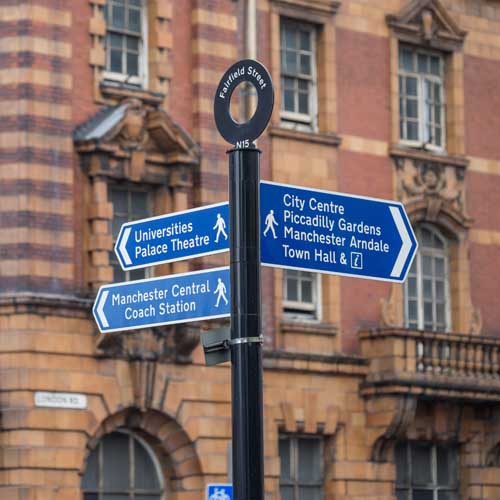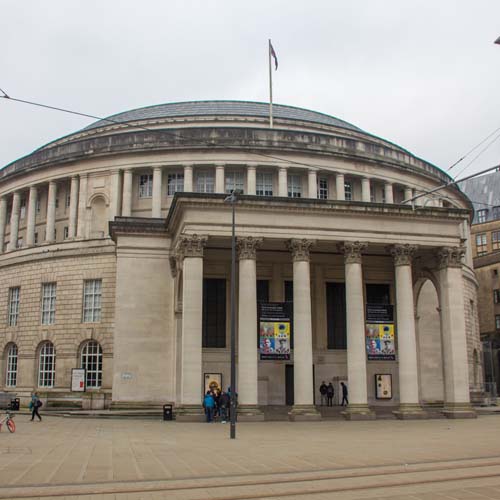Welcome to your free walking tour of Manchester. You will learn how Manchester is a city of firsts, from the first place where women campaigned for the vote, through to the start of football leagues across the world, all the way through to the first ice-cream as we know it today!
We start our tour at Piccadilly Gardens which is right in the centre of the city. It’s the final stop on any bus routes coming into the city or if you arrive by train it’s a short walk.
Piccadilly Gardens
When you arrive, go over to The Queen Victoria Statue. Queen Victoria was Queen of England and the longest reigning monarch from 1837 – 22 January 1901 until being surpassed by the current Queen Elizabeth II’s reign 6 years ago.
Victoria disliked Manchester and much preferred Liverpool. The original plan was for the statue to be constructed in marble but Victoria apparently said that it would become dirty in the smoky Manchester air caused by the industrial revolution.
Facing Victoria, take a right and go down to Santander bank. To the left of the doors take a look up on the wall and you will see a red plaque which signifies the building where the Football League started, later to become the Premier League. In what was once the Royal Hotel, 12 chairmen from England’s football clubs created one of the world’s most famous leagues and also set the foundation for national leagues across the world.
Now turn 180° and walk towards the “big orange building” behind the fountain.
You are now walking across Piccadilly Gardens.
Piccadilly Gardens has a long and controversial history. In the 1700s Piccadilly Gardens was home to muddy pits known as ‘Daub Holes’ which were underneath where you are now standing.
Women of ‘disrepute’ would be brought here to have their heads dunked in the muddy pits. ‘Crimes’ could be anything from having a child out of wedlock, not obeying their husband to simply being weird or ‘witchy’.
Huge amounts of spectators would come and ‘enjoy’ the spectacle, believing that the duckings would wash away the ‘sins’ of the women. It later became the site for ‘Manchester Lunatic Asylum’. The vetting is no way as robust as it is today and sane women would be institutionalised for having ‘strong opinions.’.
This is where the Library stood until the 1930’s when Manchester Central Library was opened as the biggest public library in the country.
Continue through Piccadilly Gardens towards the Orange building. There is a ‘tunnel’ with Shoryu on the right and Ask Italian on the left. Continue through the tunnel until you reach the end and take a right onto Portland Street. Continue along Portland Street and cross over the tram tracks until you reach Dawsons music shop. Opposite Dawsons is the Britannia Hotel. Cross over the road at the traffic lights for the next stop on the tour.

Britannia Hotel
You are now in front of the Britannia Hotel. Before being a hotel, this was the Watts Brothers warehouse which housed finished textiles. Take a look above the window on each floor. On the ground floor you will see there is a ship’s masthead or a ship’s bell in stone, a reference to the Manchester Ship Canal which was instrumental in Manchester maintaining its reputation as the world leader in cotton production. About 80% of the world’s cotton was produced in Manchester.
There are 5 different types of architecture at The Britannia Hotel, one for each floor. There is an Italianate style of windows on display on the first floor. On the second floor.
Above them are windows with balconies and the floral top with urns is Elizabethan style. The windows with columns in front of them are Grecian style. French renaissance is at the top with little rose windows. Finally, Flemish wheels decorate the roof which is a nod to Manchester’s past. Flemish hand loom weavers have been living here since relocating from Flanders in the 1300s.
The merchants who bought from Samuel and James Watts would travel from all over the world so the architecture was a clever marketing ploy to entice the merchants inside as well as remind them of how connected they were to Manchester. Many international traders would spend three or four weeks on a ship to cross the atlantic from America.
Standing outside the front door you can see the hotel lobby and the staircase inside is very similar to that of the Titanic which was a nod to their seafaring links. I’d encourage you to go inside as it’s a great place for you to take a photograph and pretend to be in the movie!
The mirrors that form part of the atrium were added to give these merchants a ‘home from home’ feeling. The theme continued with a familiar looking staircase.
The building was nearly destroyed in 1940 when a Luftwaffe bomb set it on fire. However, this was put out by the workers at Watts Brothers who gathered together and with bales of cotton, blankets and curtains, they managed to smother the flames and save their workplace.
Come out of the Britannia and cross the road towards Dawson’s music store and continue onto New York Street which is to the right of Dawson’s. Then take your first left onto Faulkner Street and you will see the Chinese Arch which is another great photo stop.
Chinese Arch
The Paifang arch was unveiled in 1987 by Manchester City Council to thank the Chinese population for their huge contribution to the city. The arch was built in China before being dismantled and then shipped over in three containers. Manchester is currently twinned with Wuhan, the most populous city in central China.
Manchester has the second largest Chinatown in the UK behind London and the third largest in Europe with Paris housing the largest Chinatown.
Although the Chinese Imperial arch in Liverpool is the biggest in Europe, in this case size does not matter! Manchester had their Chinese arch thirteen years before Liverpool unveiled theirs.
Continue along Faulkner Street and turn left into Nicholas Street and you will arrive back at Portland Street. Cross at the lights here and take a quick left and then the first right onto Sackville Street.
The Village
A bit further up Sackville Street you will be greeted by a pub called the Thompson’s Arms. The rainbow coloured exterior will probably let you know you have now entered the Gay Village. Indie Music fans will be interested to know that Manchester bands The Smiths had one of their first gigs here.
As you continue along Sackville Street keep an eye on the footpath for the Rainbow mosaics. There are 17 of these dotted around Manchester, part of the Manchester LGBT Heritage Trail. The significance of this first mosaic is to commemorate Albert Kennedy who fell to his death here after falling from the car park above. He was a gay adolescent living in a care home in Salford and suffered homophobic abuse. AKT.org.uk is a charity was set up in Manchester following his death in 1989 to help young gay people who are either homeless or living in a hostile environment.
Further along Sackville Street, cross Bloom Street, going past Napoleons on the right and BaBa on the left. Then take the next turn on the left onto Richmond Street.
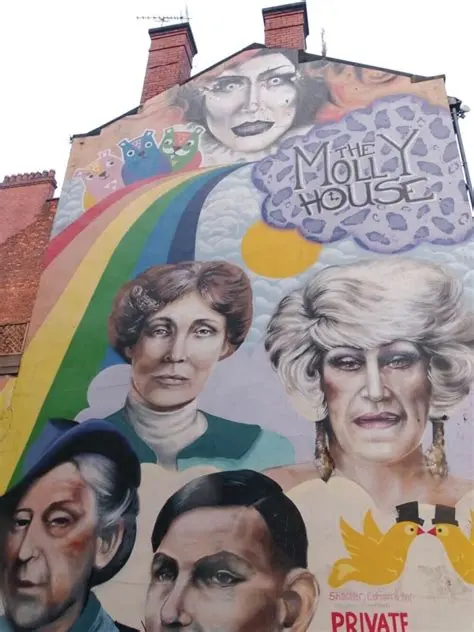
Molly House
Straight in front of you there is a huge mural of different figures connected to Manchester. This is on the side of the Molly House. A Molly House was a term used in 18th and 19th century Britain meaning a meeting place for homosexual men. It’s still essentially a gay bar now but all are welcome in this friendly place.
Whilst looking at the mural, there are four iconic figures associated with Manchester.:
Emmeline Pankhurst – Famous for campaigning for the vote for women in the UK.
Quentin Crisp – A famous transvestite, immortalised in the Sting song ‘Englishman in New York’. Quentin Crisp is the ‘alien’ and appears in the video.
Anna Phylactic – Currently doing the rounds in the Village as a drag queen.
Foo Foo Lammar – A famous drag queen compere and club owner.
Alan Turing – Famous as one of the codebreakers in WW2 and perhaps being instrumental in ending the war in Britain’s favour. Also the pioneer of artificial intelligence and the rudiments of the modern day computer and smartphone. The film ‘Imitation Game’ gives an insight into the mind of this incredible man. Played by Benedict Cumberbatch, a Manchester University alumni, the film shows the genius mind that Turing possessed.
We will now make our way towards the Alan Turing monument.
Go back and take a left into Sackville Street. Continue along Sackville Street passing the famous McTucky’s takeaway on the right. For the unaccustomed the name is a hybrid of McDonald’s and Kentucky Fried Chicken!
Sackville Street is intersected by Canal Street which is one of the most famous Gay Streets in Britain, if not the world. This is a great, safe place to have a wander through the day or for the more lively, at night time.
Crossing over Canal Street, cross the bridge over the canal until you reach ‘Sackville Gardens’. When you can, take a left into the park and follow the path until you reach The Alan Turing monument.
Alan Turing Monument
Alan Turing was a English mathematician and computer scientist widely acclaimed as being a founder of modern day computer science. As mentioned above, he greatly helped end WW2 in the allies’ favour by using Enigma Machine decryption. Alan Turing happened to be gay.
Before 1967, homosexuality was criminal in the UK. When answering to a police call for a burgary, Turing admitted being gay. He was subsequently charged with “gross indecency” and ordered to take hormonal treatment. The result of the ‘treatment’ meant that he lost his concentration and led to depression as he couldn’t work at the Government anymore.
Sadly, two years later Turing died of suicide after eating an apple laced with cyanide.
The monument of Alan Turing here is to commemorate his incredible work. If you look at the statue, you can see that Turing is shown holding an apple. On the bench is the text
‘IEKYF RQMSI ADXUO KVKZC GUBJ’.
This is the enigma machine encoding of the phrase:
“Founder of Computer Science”
It is fitting that Alan Turing is here because on his left is Manchester University his alma mater and he is facing towards Canal Street the gay area.
Facing Alan Turing, continue along the path until you reach Whitworth Street and take a left. At the traffic lights cross the road and you will see UMIST building in front of you.
Go left, following the wall and you will come on to Cobourg Street. Follow this and it will lead behind the UMIST building. Take a right here along the pedestrianised street which is Granby Row. Around 50 metres on your left you will find the Vimto Monument which is the next stop on your tour.
Vimto Sculpture
Vimto for the unacquainted is a famous soft drink from Manchester. In 1908 The UK Government passed a law restricting the amount of bars and pubs. A man named John Noel Nichols [who lived close by at 19 Granby Row] saw a gap in the market for a soft drink
Nichols wanted to invent a cordial that was so good that people wouldn’t want to drink alcohol again. Ironically enough Cheeky Vimtos, which include no Vimto but lots of alcohol can be bought at most student nights. In fact, just at the end of Granby Row on the corner of Princess Street sits Fifth nightclub where the drink is served.
Vimto sells six bottles a second as it is hugely popular in Arab States especially with children who are fasting for the first time during Ramadan and their blood sugar levels drop. There’s also an Arabic version of Vimto which is more expensive and even more syrup-like. Vimto is now on sale in about 50 percent of countries worldwide.
The sculpture itself was designed by Kerry Morrison, a fine art student at Manchester Metropolitan University in 1992 carved out of an oak tree from a sustainable forest.
No visit to Manchester is complete without you trying a bit of our local drink. Some people love it whilst others suggest that ‘Vimto’ should be an anagram of ‘Vomit’!
UMIST (University of Manchester Institute of Science and Technology)
You are currently in the grounds of University of Manchester Institute of Science and Technology (UMIST). UMIST is famous for splitting the atom, modern day computing and more recently, the invention of Graphene, the world’s thinnest material. UMIST also has 25 Nobel Prize winners.
Continue along Granby Row and cross over Sackville Street until you reach the end which will lead you to Princess Street. Go slightly uphill and until you reach the lights and take a left onto Whitworth Street where O’Shea’s pub is. You will pass India House on your left which was the home of Manchester music legends Shaun Ryder of the Happy Mondays and Noel Gallagher of Oasis. The architect of India House, Adolphe Valette taught art to Manchester painter L.S. Lowry.
Continue along Whitworth Street until you reach the traffic lights and on the left you have the Kimpton Clocktower Hotel.
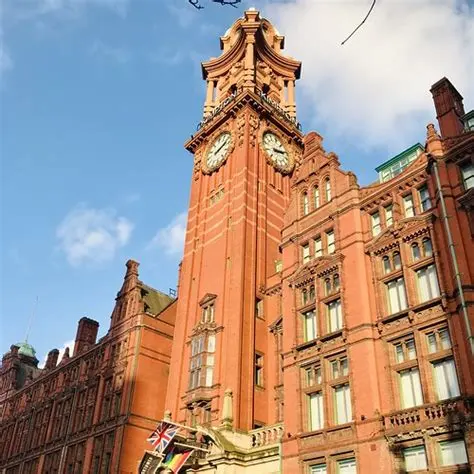
Kimpton Clocktower Hotel (The Refuge)
This Grade II* listed red brick and terracotta building was designed by Alfred Waterhouse and built and completed in 1895. Waterhouse is famous for the Natural History Museum both in London and Manchester, as well as designing Manchester’s prison Strangeways and Manchester Town Hall.
Constructed between 1891 and 1895 it originally housed the Refuge Assurance Company and then became The Charterhouse Hotel and then the Palace Hotel before finally becoming the Kimpton Clocktower Hotel.
Legend has it that when the building was closed for almost a decade from 1987 to 1996 , only two people were ever seen inside. The cleaner used to have a set of keys and come and go at varying intervals.
The other figure was also a female who would appear randomly. The ghost, so the story goes, is definitely female according to many eyewitness accounts. A room can be booked so that you can be nearer to her should this be to your taste.
Outside you can see the Kimpton clock tower. This was designed by Waterhouse’s only son Paul who grew up in Manchester and also gave us Whitworth Hall further down Oxford Road. Like Alfred, he also only had one son, Michael, who also became President of the Royal Institute of British Architects (RIBA).
Inside the building is an incredible ballroom which was once a dining hall for employees. Male and female workers were required to sit apart. Strangely, women had to reapply for jobs if they married.
Now cross Whitworth Street and you will find The Palace Theatre on your right.
The Palace Theatre
The Palace Theatre opened in 1891 and was originally known as the ‘Grand Old Lady of Oxford Street’. It had to be rebuilt after a German bomb hit during the Manchester Blitz of September 1940. Some of the original architecture such as the impressive façade and round-arch windows, remain today.
Stars who have performed here include Judy Garland of the Wizard of Oz, Laurel and Hardy and the Rolling Stones. Whilst famous visitors include both the Queen and the Queen Mother.
With The Palace Theatre on your right, continue along Oxford Street, taking care to cross the roads towards the circular building which is Manchester Central Library around 500 metres in the distance. We will be visiting the library very soon after seeing a famous woman and a short visit to The Midland Hotel.

Emmeline Pankhurst statue
Hazel Reeves was the artist behind the Emmeline Pankhurst statue that was unveiled on 14th December 2018, marking 100 years since some women were granted the vote.
Emmeline is oriented towards the former Free Trade Hall where the first Suffrage meetings took place. It was also at the Free Trade Hall in 1905 that Christabel, one of Emmeline’s daughters, attended a Liberal Party Conference with her friend Annie Kenny; this kickstarted militant action from the Suffragette movement.
Born on 15th July 1858 in Moss Side, Emmeline was a strong-willed feminist who founded the Women’s Social and Political Union in 1903. ‘Deeds not words’ was their motto. Thanks to the Representation of the People Act 1918, some women and all men were given the right to vote. But it was not until a decade later that the Equal Franchise Act of 1928 meant all women over the age of 21 could vote, finally attaining parity with men, a landmark in British history.
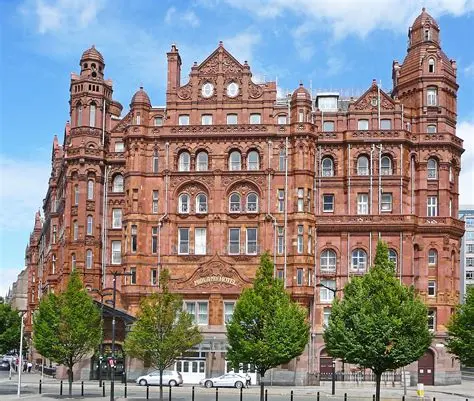
Midland Hotel
Just to the left of Central Library is the Midland Hotel designed by acclaimed architect Charles Trubshaw and it took five years to be built.
The Midland railway company set up The Midland Hotel to serve Manchester Central Railway Station. The structure, which sits behind The Midland, is now a Grade 2 listed building and after a brief spell as the Gmex is now known as Manchester Central.
Every Prime Minister of Britain that has ever been in power has stayed here including Winston Churchill. Barbara Frost writes in her book Memories of The Midland.
The French restaurant where David Beckham had his first date with his future wife Victoria of The Spice Girls. She made the first move as David was too shy and sang “If you wanna be my lover”. The Midland, you could say, is where Two Become One!
The Beatles were refused entry for not wearing the correct attire even though they were staying here at the time. The French is no longer Michelin star quality but they have managed to keep Michelin star pricing!
Take That announced their split at a press conference here in 1996 and telephone helplines were set up to help teenagers cope with the ordeal, some of whom went on hunger strikes.
Charles Rolls had a meeting with Henry Royce here in 1904 which led to the birth of the first Rolls Royce factory about a mile away in Hulme. On the right of the doorway before entering the hotel lobby you will see a copper sculpture showing Rolls and Royce shaking hands, with a car in the background of the image.
The bell on top of the Town Hall near Midland would chime on the hour every hour of the day. However, guests at The Midland complained and this led to a change in the law meaning that the bell now stops ringing at 11pm and resumes again at 7am the following morning.
Over the years, staff and guests have reported appearances of the ghost of the ‘lady in grey’, who lived in the hotel in the 1930s, and vowed she would never live elsewhere.
When you have finished at the Midland, Cross over the Road and make your way to Central Library where we continue our tour.
Central Library
Construction of Manchester Central Library completed in 1934. Take a look at the front door and on the left of it you will see a brick with the word ‘Ireland’ on it. You may notice this is a different colour to the rest of the bricks. The reason is because Irish immigrants in England kept removing the brick because of its colonial connotations.
Now step into the lobby of Central Library and CHECK you will see it is decorated in stained glass which includes a portrait of Shakespeare and some scenes from a selection of Shakespeare plays.
The Bee straight ahead and slightly left is one of the Bee in the city art installations of 2017. Bees are the symbol of Manchester and they denote the work ethic of Manchester people.
Walk up the stairs into the main library passing a marble statue of a girl reading a book. Enter the main library and marvel at the architecture.
Anthony Burgess who wrote the novel A Clockwork Orange as well as The Smiths frontman Morrissey were regular visitors to the library.
There is a cafe in the basement if you wanted to get a refreshment. When you are ready you can now leave the library through the main entrance and turn left making your way to the red phone box.
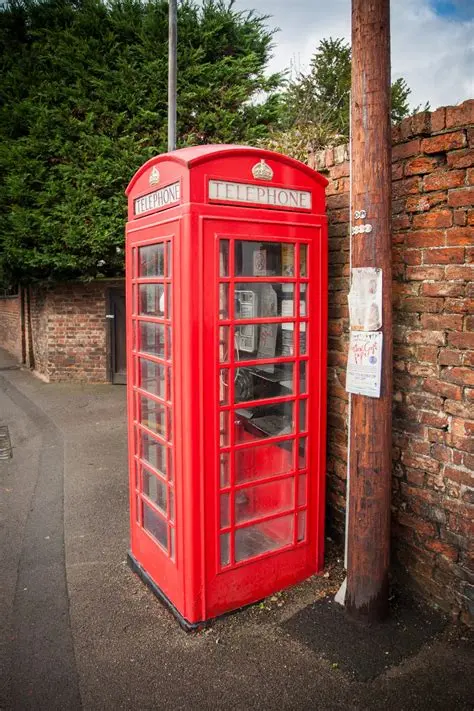
Red Phone Boxes
We stop here because red phone boxes are well known as a British cultural icon throughout the world. Numbers have markedly decreased since the advent of mobile phones but you can still use them if you have a spare 50p CHECK. Interestingly, you can find these booths in former colonies of the British Empire including in Bermuda and Malta. This is a great place for a photo.
Now to the left of the phone boxes you will see a glass tunnel [now covered] until you reach Albert Square
Inside the tunnel you can see the floor is decorated with 18 red roses which commemorate the eighteen people who died at a peaceful protest just near this building. Their names are written on the floor and when the sun, or any other light shines on them they light up.
Follow the curve of Central Library and when you reach the end of the walkway. Take the first right along the arches [Mount Street] and you will arrive at Albert Square. Make your way to the steeple-like structure in front of you and a bit to the left. This is the Statue of Prince Albert who loved Manchester and apparently said ‘What they do here today, the rest of the world does tomorrow’.
Now turn around and have a look at the splendour of Manchester Town Hall.
Town Hall
Manchester Town Hall is regarded as one of the best examples of Neo-Gothic architecture in the whole of the United Kingdom. It is also one of the most important Grade I listed buildings in England.
Because of its similarity to Westminster which is the Governmental headquarters of the UK in London, Manchester Town Hall and surrounds have often been used as substitutes in both film and television.
Sherlock Holmes, House of Cards, The Iron Lady and The Forsyte Saga have all been filmed here.
On top of the building is a spherical spiky cotton ball, [known as a ‘bol’] which symbolised Manchester’s cotton industry. It is golden because it’s meant to represent the sun. So wherever the sun was shining Manchester’s goods would be there.
The Bell in the clocktower has words written underneath which in Latin mean the equivalent of ‘Live each day as though it were your last’ and ‘cherish each moment because they are all precious’.
Behind Prince Albert there is a road and on the other side there is a row of cafes. Turn left and you will see The Slug and Lettuce on the right hand side. Go straight along Cross Street.
On your left you will see a gold postbox. Usually postboxes in the UK are red in colour. The reason for the gold postbox here is dedicated to Phillip Hindes who won a gold medal in the 2012 olympics for cycling who trained with Team GB in Manchester.
Now Between the Square Albert pub and Southmill Street/Red Barbeque continue along this road until you get to The Radisson Blu Hotel.
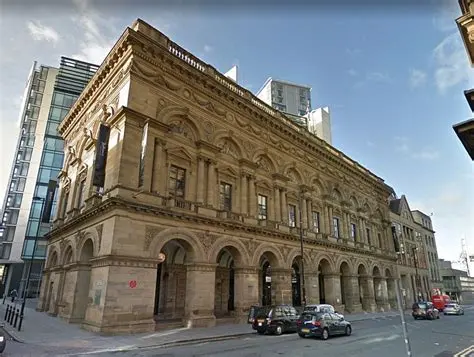
The Radisson Blu Hotel (The Free Trade Hall)
The Radisson Blu Hotel was once known as The Free Trade Hall. Today it is a Grade II* listed building.
Edward Walters designed the Free Trade Hall which was constructed between 1853 and 1856. It was built to commemorate the repeal of the Corn Laws in 1846 which were a way of taxing the poor who worked on the land.
On the front of the building you can see a red plaque which commemorates the ‘Peterloo Massacre’ of 1819 where protestors were killed simply for demonstrating for the right to vote. Standing under the red plaque and looking towards the Town Hall you will see the wall where most of the deaths would have occurred.
The Free Trade Hall was also the site of where the suffragette movement [women’s right to vote] would meet. This was instrumental in giving Women the vote in the UK.
More recently in 1951 after an extensive renovation, the building became a concert hall and hosted many famous names. The Free Trade Hall was the site of the infamous incident where someone shouted ‘Judas’ at Bob Dylan for playing an electric instead of an acoustic guitar.
In 1976 The Buzzcocks invited The Sex Pistols to play at the Lesser Free Trade Hall, which inspired Joy Division and The Fall to start bands. Other musicians who claimed to be present included Mick Hucknall of Simply Red, and members of The Smiths and The famous Manchester record label Factory Records.
With your back to the front door of the free trade hall, turn left and continue on Peter Street past the Great Northern Railway building on your left until you reach the traffic lights. At the lights turn right onto Deansgate and continue for 300 meters until you reach John Rylands Library on your left.
John Rylands Library
Often referred to as the Taj Mahal of Manchester, John Rylands Library is a neo Gothic building that has the look and even feel of a church. Featuring sculptures, stained glass and arches there is a charm about this beautiful building that few others in Manchester can match.
Born in 1801, John Rylands was a successful cotton merchant based in Manchester. In fact, he became Manchester’s first multi-millionaire. When he died he left the largest estate ever left by a non-aristocrat to his wife Enriquetta. Enriquetta commissioned the building of the library to commemorate the life of her husband and it opened in 1900, 2 years after his death.
There are over a million items spanning over 5,000 years. There is a surviving papyrus containing a New Testament text which could be one of the earliest surviving biblical texts. The papyrus is in a glass cabinet on the ground floor.
Notes and letters from novelist Elizabeth Gaskell and physician John Dalton are also within these walls. You can also find early works by William Shakespeare.
Periodically, you can see a working demonstration of how books were printed in the past which is very interesting for children so if you get a chance to see this it’s well worth the effort.
When you have finished with the splendour of the library, exit and continue along Deansgate for around 500 meters passing the Sawyers Arms, where Friedrich Engels used to drink along the way. Further on past The Sawyers you will pass Forsyths Music Shop on the same side which is the oldest retail shop in Britain opened in 1857. Further along, you will see Manchester Cathedral in front of you so continue until you are in the grounds of the Cathedral.
Manchester Cathedral
Originally, Manchester Cathedral was just a local parish church. The church became a cathedral in 1847, when the Diocese of Manchester was created. The church is built in Gothic style and is one of fifteen Grade I listed buildings in Manchester.
Enter the church and go to the end of the church and take a right. Here you will see a stained glass window decorated by fire. This is to symbolise where a bomb came through the window during the Manchester blitz. Take a look to the right of the window and you will see a statue of a boy with a foot missing. This foot was lost in the same bombing raid but the rest of the statue survived.
Upon leaving the church and turn left following the low level perimeter wall which is on your left. When you reach the building facing you take a right and you will now be facing the Corn Exchange.
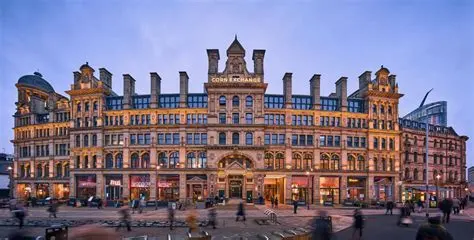
Corn Exchange
The Corn Exchange is a protected Grade II listed building. As the name suggests this was the place where corn was traded from the 1800’s until the 1900’s. At that time it attracted thousands of traders from around the region until the economic depression of the 1920’s and 1930’s. It then became an artisan shopping area attracting many alternative communities but now houses a food court and many mid-range restaurants.
As you face Selfridges, turn right and now you are facing the square known as Shambles Square.
Shambles Square
Shambles Square looks very different now to how it looked in the 1500s as a meat selling area with blood running down the streets. Eventually, the area became an integral part of Manchester commerce with the construction of The Corn Exchange.
However, on 15 June 1996 at 11.17 AM. A huge bomb ripped through the heart of Manchester damaging many iconic buildings including the above mentioned Sinclairs Oyster Bar and Old Wellington. The roof of the Edwardian Grade II listed building Royal Exchange close by actually blew off and miraculously landed back in place almost like in a cartoon.
The result of the bomb was literally a shambles. However, it’s great to see it’s now been revitalised and is once again a vibrant part of the city.
Now we are drawing to a close of your free Manchester Walking Tour and we end it at one of Manchester’s most iconic places – Sinclairs Oyster Bar and Old Wellington.
Sinclair’s Oyster Bar and Old Wellington
The Old Wellington and Sinclair’s Oyster Bar are two of Manchester’s best loved pubs. Built in 1552 they moved to their present location after the 1996 bomb. They were dismantled into more than 10,000 parts with each piece being meticulously labelled, recorded and photographed to enable the reassembling of the buildings back to their original grandeur.
The outside of the pubs is quite stunning and with its black and white beams it is very instagram friendly.
Visitors should take the time to have a look inside to meander the low ceilings and tight staircases and get a glimpse of Tudor pub life. Inside you will see old exposed beams and old pictures of the pub. Today it’s a great meeting place for tourists and surprisingly boasts some of the most reasonable prices in the centre. The pub tries to recreate the times of old with the art of conversation and has a no phones policy on the entire premises (including on the benches outside!). It can actually be quite a refreshing and liberating change to escape your smartphone!
Whilst you are having a drink here you can have a think that this space was in fact a makeshift graveyard for the poor who couldn’t afford to be buried in the nearby Cathedral. After the 1996 bomb and during reconstruction, a huge amount of human bones were discovered. Before construction could continue, a blue forensic-style tent was erected to cover the excavation.
If you are sitting outside and you’re not allowed to check your phone you won’t have much luck by looking at the clock on the corner of the two pubs as it doesn’t work. It is stuck at 7.50 although that means it’s correct twice a day! Apparently there is no significance to this time but feel free to speculate!
Conclusion
It is fitting to end our tour here because Shambles Square and Sinclairs Oyster typifies the character and resilience of Manchester. Manchester overcame many obstacles in its history such as the Manchester blitz bombings, the ending of the cotton trade as well as several terrorist attacks. Manchester has always bounced back and refuses to lie down without a fight.
Just like the first pubs to ever be moved twice, as I said at the start of the tour, Manchester is famous for many other firsts. From the first vegetarian society, to the first atom split, the formation of The Royal Society for the Protection of Birds through to the world’s first football league. Manchester continues to innovate through to this day with new ideas and investment and is leading the way with the world’s thinnest material known as graphene.
We hope that you enjoyed your free Manchester Walking Tour! So please tell us, what is your favourite free thing to do in Manchester? And what can we include on our next tour


